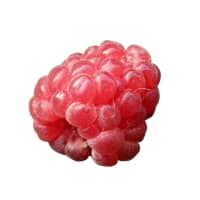Raspberry[1]
Healing Properties
Antioxidant
Free radical scavenging.
Brain Health
Neuroprotective
Anti-Glycation
Glycation is associated with several neurodegenerative disorders, including Alzheimer’s disease (AD, where it potentiates the aggregation and toxicity of proteins such as β-amyloid (Aβ).
- Glycation is a process that interferes with the molecular and cellular functioning of the entire body. It involves the release of highly oxidizing side-products such as hydrogen peroxide.
- Damage by glycation results in stiffening of the collagen in the blood vessel walls, leading to high blood pressure, especially in diabetes.
- Glycations also cause weakening of the collagen in the blood vessel walls, which may lead to micro- or macro-aneurisms; this may cause strokes if in the brain.
- Parts of the body most at risk to the affects of glycation are: Long-lived cells (such as nerves and different types of brain cell), long-lasting proteins (Cells such as the retina cells in the eyes; crystallins of the lens and cornea), and DNA may accumulate substantial damage over time.
- Red blood cells have a consistent lifespan of 120 days and are easily accessible for measurement of glycation.
Microglial Protection
Polyphenol & anthocyanin-enriched extracts of blackberry help protect the brain’s microglia. Microglia are a type of glial cell located throughout the brain and spinal cord. Microglia account for 10–15% of all cells found within the brain. Microglia act as the first and main form of active immune defense in the central nervous system.
- Decreased cytotoxicity in microglia.
- Prevents Ameloydβeta fibrillation
Disease / Symptom Treatment
Neurodegenerative Diseases
Alzheimer’s
Title: Evaluation of Polyphenol Anthocyanin-Enriched Extracts of Blackberry, Black Raspberry, Blueberry, Cranberry, Red Raspberry, and Strawberry for Free Radical Scavenging, Reactive Carbonyl Species Trapping, Anti-Glycation, Anti-β-Amyloid Aggregation, and Microglial Neuroprotective Effects
Author(s): Hang Ma 1,2,3,†Orcid, Shelby L. Johnson, Weixi Liu, Nicholas A. DaSilva, Susan Meschwitz, Joel A. Dain, and Navindra P. Seeram
Institution(s): School of Chemical and Environment Engineering, Wuyi University; International Healthcare Innovation Institute (Jiangmen), Jiangmen 529020, Guangdong, China, Bioactive Botanical Research Laboratory, Department of Biomedical and Pharmaceutical Sciences, College of Pharmacy, University of Rhode Island, Kingston, RI 02881, USA, George and Anne Ryan Institute for Neuroscience, University of Rhode Island, Kingston, RI 02881, USA, Department of Chemistry, University of Rhode Island, Kingston, RI 02881, USA, Department of Chemistry, Salve Regina University, Newport, RI 02840, USA
Publication: International Journal of Moleculary Science
Date: Feb 2018
Abstract: Glycation is associated with several neurodegenerative disorders, including Alzheimer’s disease (AD), where it potentiates the aggregation and toxicity of proteins such as β-amyloid (Aβ). Published studies support the anti-glycation and neuroprotective effects of several polyphenol-rich fruits, including berries, which are rich in anthocyanins. Herein, blackberry, black raspberry, blueberry, cranberry, red raspberry, and strawberry extracts were evaluated for: (1) total phenolic and anthocyanins contents, (2) free radical (DPPH) scavenging and reactive carbonyl species (methylglyoxal; MGO) trapping, (3) anti-glycation (using BSA-fructose and BSA-MGO models), (4) anti-Aβ aggregation (using thermal- and MGO-induced fibrillation models), and, (5) murine microglia (BV-2) neuroprotective properties. Berry crude extracts (CE) were fractionated to yield anthocyanins-free (ACF) and anthocyanins-enriched (ACE) extracts. The berry ACEs (at 100 μg/mL) showed superior free radical scavenging, reactive carbonyl species trapping, and anti-glycation effects compared to their respective ACFs. The berry ACEs (at 100 μg/mL) inhibited both thermal- and MGO-induced Aβ fibrillation. In addition, the berry ACEs (at 20 μg/mL) reduced H2O2-induced reactive oxygen species production, and lipopolysaccharide-induced nitric oxide species in BV-2 microglia as well as decreased H2O2-induced cytotoxicity and caspase-3/7 activity in BV-2 microglia. The free radical scavenging, reactive carbonyl trapping, anti-glycation, anti-Aβ fibrillation, and microglial neuroprotective effects of these berry extracts warrant further in vivo studies to evaluate their potential neuroprotective effects against AD.
Link: http://dx.doi.org/10.3390/ijms19020461
Citations: ↩︎
